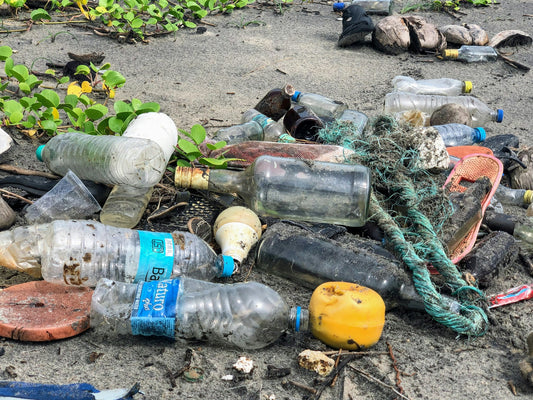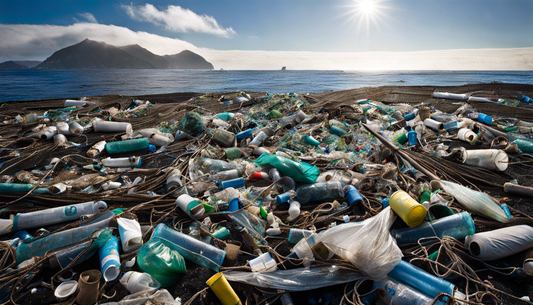Share
Imagine sipping a glass of water only to get infected by microplastics and chemicals in it.
When people hear of plastic pollution, they are likely to envision pictures of oceans filled with trash and animals entangled in plastics or starving to death due to plastic ingestion.
Unfortunately, the majority of people have no idea that the negative impact of plastic pollution does not only affect wildlife and landscapes.
In fact, plastics are a danger to human health, entering our bodies and becoming an integral part of our lives.
Plastic pollution has a range of negative impacts on human beings and has even become a leading cause of death globally.
The Extent of Plastic Pollution

It is an undeniable fact that plastic pollution has grown to the point of becoming a global problem.
Around 300 million tons of plastic end up in the global waste basket every year and more than 8 million tons of it finds its way to the seas. This figure is however likely to go up as shown above if the current trends persist.
Plastic is as pervasive as it could get and has infiltrated every part of our lives. From the food we eat to the clothes we wear, plastic is around us all day every day. Combined with the global consumerism and throw-away culture, this plastic flood is a recipe for disaster.
With more and more plastic being produced, we are running out of time to deal with the arising problems and proper disposal. Plastic does not biodegrade.
Every piece of plastic ever created is still on earth in some form, breaking down into microplastic and releasing toxic chemicals.
Microplastics and Human Health
A particularly prevalent type of plastic pollution is microplastics, which are plastic particles with a size of up to 5mm. These particles are so common that they exist in water, soil, and even the air we breathe in.
Microplastics have been identified in human blood, placenta, and fecal matter, indicating the dangers they pose to humans. An average person could be ingesting approximately 5 grams of plastic every week.
The stats on microplastics are very surprising. Microplastics have been found in 83% of tap water worldwide, whereas in the USA, 94% of the tap water samples were detected with microplastics.
This is not even to mention bottled water, which emits even more microplastics and is a significant polluter.
While the breadth of consequences from microplastics exposure are still being researched, what we know of is already terrifying.
There are dozens of severe medical conditions that are caused by plastic and researchers uncover new ones every year, from cancer, to male and female infertility, to lung diseases.
Just in May this year, a study shocked the world where researchers published findings about microplastics in testicles, which could be a leading cause of male fertility.

Direct Impacts on Human Health
Contaminated Water Sources
Waterborne diseases are spread by plastics in water sources that are for human consumption.
According to WHO, waterborne diseases contribute to more than 1 million diarrheal deaths annually.
Not all of these deaths are caused by plastic pollution, but the existence of plastics makes matters worse by offering a fertile ground for bacteria and other pathogens to thrive.
Toxic Chemicals and Cancer
Plastics are filled with a number of toxic substances, such as BPA, phthalates, and flame retardants.
These chemicals can migrate into food and water, thus posing serious health risks, including cancer, endocrine disruption, and reproductive health complications.
Some of the chemicals used in plastics have been categorized as carcinogenic by the International Agency for Research on Cancer (IARC).
Take Action Now! Replacing the dish soap and plastic brushes in your kitchen can be and easy way to reduce toxic chemicals in your life.
Effects of Air Pollutants on Respiratory Diseases
Open burning of plastic waste emits a mixture of toxic gases such as dioxin, furan, and heavy metals that cause air pollution.
According to the World Health Organisation, air pollution causes 7 million deaths annually due to diseases, including lung cancer, stroke, and chronic respiratory diseases.
Although not all of these deaths are blamed on the burning of plastics, it is a major cause, particularly in areas where waste disposal involves burning.
Poor waste disposal and burning of plastics are leading causes of air pollution in developing nations. These pollutants aggravate respiratory illnesses and hence increase mortality levels.
Case Studies and Stats on Effects of Plastic Pollution on Human Health

Manila Bay, Philippines
One of the worst effects of plastic pollution includes health implications, an example of which is Manila Bay in the Philippines.
People living near the communities are affected by several diseases that are associated with the consumption of contaminated water, such as cholera, typhoid, and hepatitis A.
This is made worse by the burning of plastic waste, an act that produces hazardous smoke in the atmosphere.
These fumes have been attributed to the rise of respiratory diseases like asthma and chronic obstructive pulmonary disease (COPD) among the people of Indonesia.
The study done on households around Manila Bay revealed that 57% of households had at least one family member affected by a waterborne disease within a year.
Dandora Dumpsite, Kenya
The effects of plastic pollution on the health of people living around the dump site can also be seen in Dandora dump site in Nairobi-Kenya.
These toxic compounds have been associated with adverse health implications, which include respiratory diseases and cancers.
Research conducted by the United Nations Environment Programme (UNEP) reveals that more than half the children from the community close to the Dandora dumpsite have respiratory diseases and blood disorders associated with toxicity.
It is also evident that waste pickers, who are in daily contact with different types of plastic waste, are more prone to develop long-lasting health issues.
Buriganga River, Bangladesh

High levels of plastic waste threaten the health of the people living in the Buriganga River in Dhaka, Bangladesh.
Industrial plastic waste is the main culprit since it brings toxic chemicals into the water.
Research was conducted that indicates that people who drink river water experience severe stomach diseases, while people who use it for washing experience skin diseases.
Millions of people are threatened by the pollution in the Buriganga river, as this essential waterway is dying out.
How Many Deaths Are Linked to Plastic Pollution
The human impact of plastic pollution is a hidden epidemic that requires urgent action.
The effects are all too real, whether from polluted water supplies, poisonous chemicals, or hazardous air.
While it is challenging to estimate the exact number of deaths that result from plastic pollution every year, the estimates are beyond shocking.
The famous environmental advocate Sir David Attenborough spearheaded a study that revealed between 400,000 and one million people die each year from plastic pollution.
This includes all of the above reasons from chemical exposure to waterborne diseases, to fumes from burning plastic.
To give you an idea of the magnitude of this number: This is comparable with the number of people dying from HIV (635,000) and people dying from traffic accidents (1.3 million) globally.
You can play your part in minimizing the extent of this issue.
What Needs to be Done to Address the Problem of Plastic Pollution?

Decreasing the Use of Plastics
The best solution for tackling the issue of plastic pollution is to minimize the use and production of plastic material.
Some of the ways that governments, businesses, and individuals can contribute include incorporating the use of biodegradable materials, banning plastics, and encouraging individuals to use recyclable materials.
Improving Waste Management
One of the most effective ways of reducing waste is to enhance the disposal systems to reduce the chances of plastics polluting the environment.
This involves providing support to recycling companies, supporting the establishment of waste to energy plants, and proper disposal of waste in the right methods through the use of proper landfills.
Promote Alternatives to Plastics
Nowadays, there are many products that are not made of plastic available in the market, so people should encourage eco-friendly brands as they are trying to contribute towards a good cause.
You should check out our range of plastic free products and contribute your part in making the right choices.
What are your thoughts about the health impacts of plastic pollution? Leave a comment below and engage in the discussion!
We hope you enjoyed this article. If you want to read more like this, make sure to check out our Blog and follow us on Instagram. If you are interested in truly sustainable products, check out our Shop.









2 comments
Elaine, we couldn’t agree more! We can only spread the word and create enough public pressure so something changes.
The dangers of plastics have been known for over 50 years. Why isn’t it publicized.more? Plastic has invaded our lives. How do we reverse the use of plastics.?